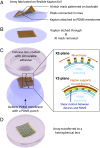From 2D to 3D: Strain- and elongation-free topological transformations of optoelectronic circuits
- PMID: 30755534
- PMCID: PMC6410875
- DOI: 10.1073/pnas.1813001116
From 2D to 3D: Strain- and elongation-free topological transformations of optoelectronic circuits
Abstract
Optoelectronic circuits in 3D shapes with large deformations can offer additional functionalities inaccessible to conventional planar electronics based on 2D geometries constrained by conventional photolithographic patterning processes. A light-sensing focal plane array (FPA) used in imagers is one example of a system that can benefit from fabrication on curved surfaces. By mimicking the hemispherical shape of the retina in the human eye, a hemispherical FPA provides a low-aberration image with a wide field of view. Due to the inherently high value of such applications, intensive efforts have been devoted to solving the problem of transforming a circuit fabricated on a flat wafer surface to an arbitrary shape without loss of performance or distorting the linear layouts that are the natural product of this fabrication paradigm. Here we report a general approach for fabricating electronic circuits and optoelectronic devices on nondevelopable surfaces by introducing shear slip of thin-film circuit components relative to the distorting substrate. In particular, we demonstrate retina-like imagers that allow for a topological transformation from a plane to a hemisphere without changing the relative positions of the pixels from that initially laid out on a planar surface. As a result, the resolution of the imager, particularly in the foveal region, is not compromised by stretching or creasing that inevitably results in transforming a 2D plane into a 3D geometry. The demonstration provides a general strategy for realizing high-density integrated circuits on randomly shaped, nondevelopable surfaces.
Keywords: semiconductor processing; sensor arrays; topological transformation.
Conflict of interest statement
Conflict of interest statement: Several intellectual property disclosures have been submitted to the University of Michigan’s Office of Technology Transfer over the years that this work was carried out. Several of these disclosures have resulted in provisional and US utility patents. No license agreements have been established with third parties.
Figures




Comment in
-
QnAs with Stephen R. Forrest.Proc Natl Acad Sci U S A. 2019 May 7;116(19):9147-9148. doi: 10.1073/pnas.1903867116. Epub 2019 Apr 22. Proc Natl Acad Sci U S A. 2019. PMID: 31010923 Free PMC article. No abstract available.
References
-
- Guenter B, et al. Highly curved image sensors: A practical approach for improved optical performance. Opt Express. 2017;25:13010–13023. - PubMed
-
- Dinyari R, Rim S-B, Huang K, Catrysse PB, Peumans P. Curving monolithic silicon for nonplanar focal plane array applications. Appl Phys Lett. 2008;92:091114.
-
- Rim S-B, Catrysse PB, Dinyari R, Huang K, Peumans P. The optical advantages of curved focal plane arrays. Opt Express. 2008;16:4965–4971. - PubMed
-
- Fan D, Lee K, Forrest SR. Flexible thin-film InGaAs photodiode focal plane array. ACS Photonics. 2016;3:670–676.
-
- Ko HC, et al. A hemispherical electronic eye camera based on compressible silicon optoelectronics. Nature. 2008;454:748–753. - PubMed
Publication types
LinkOut - more resources
Full Text Sources
Research Materials

